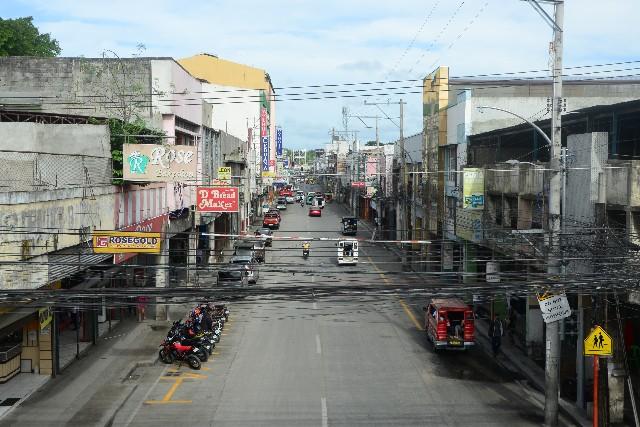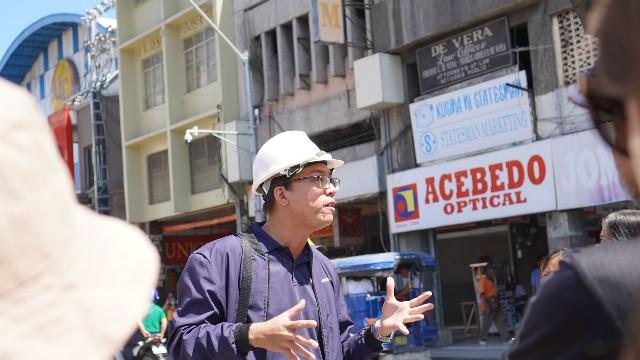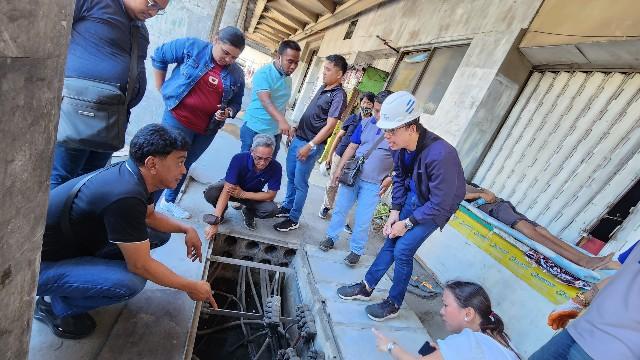DAVAO CITY – The Kadayawan Festival is the most anticipated event in Davao City. Both locals and tourists flock to the streets to witness the colorful floral float parade and street dance performances featuring the 11 ethnolinguistic tribes of Davao City. These activities start from Roxas Avenue going to C.M. Recto, Bonifacio Street, Pelayo Street, and end at San Pedro Street.
When you have time to look up from the colorful floats and dance performances, you may notice that overhead power lines and cables along C.M. Recto Avenue, San Pedro Street, and San Pedro Square, are gone, giving you a clear view of the sky. This is because the local government of Davao City has mandated the transfer of electric power and telecommunications wires and cables from overhead to underground.
The project was piloted in 2014 under City Ordinance No. 0177-14 Series of 2014 or “An Ordinance Placing Underground All Electrical and Telecommunication Wires and Cables Within the Vicinity of City Hall and the Sannguniang Panlungsod of the City of Davao.”

At that time, the technology and method used were simple: the wires were transferred by directly burying them underground. Meaning, the contractors break the concrete in the streets and then excavate them; then the pipes that protect the electric wiring called conduits were placed; third, the secondary electric wires (220 volts) were inserted into the conduits while the primary lines carrying a voltage of 13.8kV were directly buried along the road; before finally, the streets were restored. Only until then will the overhead wires be removed.
In 2020, after the success of the pilot underground cabling project around San Pedro Square, the City Ordinance No. 0152-17 Series of 2017, also known as “An Ordinance Requiring All Telecommunication Companies, Davao Light and Power Company, and all other Persons to Comply with the Underground Cabling Plan of the City of Davao,” was enacted to include multiple target locations for undergrounding. The following areas include C.M. Recto; San Pedro; R. Magsaysay Avenue; C. Bangoy Sr., Bonifacio, and Pelayo; and E. Quirino Streets. The project was targeted to be completed by 2029, as forecasted by the Wires and Cables Committee.
The underground cabling project aims to upscale the image of Davao to be internationally competitive and enhance the safety and reliability of power and telecommunication services not just in the known Kadayawan Route, but also in the Central Business District.
To understand the process of implementing the underground cabling project in Davao City, Davao Light and Power Co., Inc. (Davao Light) project lead and design engineer, Engr. Prince Rainier Yamyamin, recall the process of the project’s implementation at C.M. Recto Avenue and San Pedro Street.

“The target areas defined under this ordinance are under the ‘Kadayawan Route.’ The majority of these streets are the highlight areas during major Kadayawan events like the Indak-Indak and Floral Float parades. These areas were chosen based on their historic and economic significance,” Engr. Yamyamin explained in an interview.
For Davao Light, Prince handled the underground cabling project in C.M. Recto and San Pedro Streets from 2017 to 2022. “I was assigned to a phase where everything seemed to be new – the type of existing overhead power lines, the geographics, the required and applicable methodology, among others,” he shared the various innovations of the C.M. Recto undergrounding project and how it transfers the electric wires using conduits compared to directly burying them underground.
“Transferring the wires underground using conduits means we excavate, lay out the conduits, then insert the cables for the primary lines along the road and secondary electric lines along the sidewalks,” Prince explained. Compared to directly burying the wires underground, the semi-direct method is easier to maintain and offers more protection from physical damage since all the cables run through conduits.

Other innovations implemented during the first phase in C.M. Recto Avenue and the second phase in San Pedro Street are the different kinds of transformer installation. A transformer is an electromagnetic device that transforms voltage based on the service requirement of the customer.
Underground line facilities usually involve transformers installed on the ground through pad-mounting. In C.M. Recto, a platform-type transformer was installed. Meaning, the pad-mounted transformers are were elevated and installed on alley-type structures, also known as platform-type transformer installation. A different approach was implemented in San Pedro Street. This time, the transformers are installed on poles along adjacent streets that are not part of underground cabling areas. The transformer input comes from the overhead lines but the output goes to the customers through the underground lines. These are Davao Light’s efforts to avoid inconveniencing Davaoeňos further with pad-mounted transformers obstructing public sidewalks which are only two to three meters wide.
Admittedly, Prince shared that undergrounding is not a common technology in the Philippines and even in some other parts of the world, thus the engineers involved in the project are pushed to be open-minded, objective, and innovative to apply the correct method for the current scenario.
“The implementation of underground cabling was not an easy journey. There came a time when our frustrations tried to eat us as the target date for the completion of the projects get nearer and nearer. As much as it was my first time handling this type of project, it was also a first time for our civil and electrical [engineering] contractors,” Prince shared his experience in keeping up with their targets, like clearing out all overhead lines in San Pedro Street before the Araw ng Dabaw Celebration last March 2023.
Other challenges the project implementors faced include right-of-way, traffic and weather conditions, and obstructing water lines and drainages, among others.
Since the success of the recent underground cabling project in San Pedro Street that garnered public attention, several universities and local government units from all over the Philippines have visited Davao City to benchmark the said undergrounding project.
“We didn’t expect the attention on the project. It was heartwarming and overwhelming when people started going to us on these benchmarking activities. It is humble proof that Davao Light is already empowering our cities with the technology of undergrounding,” Prince said. He is also not hesitant to share the undergrounding methods and technology employed in Davao City with other local government units of Butuan, Bataan, Mandaluyong, Naga, and Zamboanga Peninsula.
Currently, the first part of the underground cabling project in Ramon Magsaysay Avenue, which focuses on electrical works, is ongoing. Prince expresses his support for the future developments of the underground cabling project as he looks forward to “doing better and better in each phase [to level] up with the good practices and standards in Davao Light.”
The underground cabling project along with other digitalization projects in partnership with the local government of Davao aims to empower the city through the tools and services Davao Light provides. (Davao Light)

